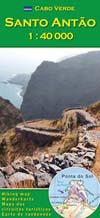| photos : GPS tracks : Alpenzorro’s GPS tracks
Getting there
Info
 |
Prior to our second visit Tracey found Alpenzorro’s account on a German mountain biking forum. We made a copy of his GPS tracks for our own use and have kept it in case it helps other people too.
Where to stay
Mostly we stayed in a rented house in Lombo Branco. We also spent a little time at the Pedracin Village Hotel and at the Santantao Art Resort, Porto Novo. We hope that one day some accommodation will appear at Ribeira da Cruz.
There are other places to stay in the tourist resorts and scattered randomly around the island.
What to eat
If you stay at a hotel, you will find the food a little unvaried. If you cater for yourself, you will be at your wits’ end to find sufficient variety. Porto Novo is better stocked than Ribeira Grande. Most of the bread is too sweet – we cooked things like fried rice for breakfast.
The Pedracin hotel is a convenient lunch stop for some routes. It has spag, and also Crocs – rum ice cream – which are too good to miss. Maracujá is another good lunch stop whose house cocktail is a highlight.
For our second visit we took a few goodies to add variety. However it is hard to guess what to take, since it’s fresh food which is mostly lacking. Things like olives are easy to find, and you can even buy soft-dried bananas which are unobtainable in the UK. The delicious local cheese is for export only (to Mindelo); the shops have Edam.
Getting around
If you travel under your own steam, you will get very bored with the Corda road. The local taxis (aluguers) are mostly pickups with benches and are happy to carry bikes. Two cyclists with their bikes nearly fill one, so a charter is perfectly reasonable. It adds to the cost, but Cape Verde is otherwise cheap.
When to go
We have always gone in January. The rainy season is in summer and early autumn. If you manage to go just after it ends you will probably find the island greener and the air clearer.
Routes
The walking routes (which are the mountain-biking routes) are mule tracks, often cobbled, which find a way down impossibly steep-looking slopes. If you get a view of one it may appear terrifying, but they aren’t so bad when you’re on them. There are far more walkers than mountain bikers, and not many mules.
Route 101: a brilliant descent, the most popular route on the island. Don’t miss the continuation through Paúl itself, which has some challenging steps.
Route 105: a nice route, but too hard for us to ride.
Route 106: we haven’t tried this, and have heard mixed reports of its difficulty.
Route 106a/104: we made a nice, fairly easy and untechnical circuit of this, climbing route 104 on foot.
Route 107: a nice route, but too hard for us.
Route 108: again nice, but too hard for us.
Route 201: we took a look at this on foot, and didn’t think it was an MTB route.
Route 203: begins attractively but becomes a spiral staircase. We backed off.
Ribeira da Torre: at the end of the road instantly becomes an unrideable footpath.
Route 205: an excellent route, not too hard and pleasantly situated.
Route 205a: rubbly, not very rideable and not very scenic.
Route 206: very enjoyable and not too hard.
Route 208: another superb route.
Route 208a: a spur off route 208, and not as good.
Route 212: very enjoyable and different in character from most routes on the island. You can try to catch an aluguer in Cruzinha (which is what walkers do) or cycle back the long way – which makes quite a hard day.
Route 213 (eastern part): a good route, which can be ridden in descent and pushed in the other direction. The continuation westwards looks equally feasible.
Routes 213/213a: a moderately enjoyable, fairly easy circuit with no exposure.
Route 301: a long route, very enjoyable at the top, rather a drag lower down on a rubbly disused road.
Route 309: an excellent long ride. You need an aluguer to get to the start and some supplies to keep you going. The descent is a sequence of tight exposed hairpins: how much you ride depends on how brave you are.
‘Route 313b’: nice and scenic as far as Baboso. We were unable to follow route 313a owing to a mule blocking the path. There seemed to be no one around to help, so we pushed up a footpath instead. The road from Titono has been rerouted. We followed what was shown as a road on the map and found it disused, while the higher and parallel mule track is now the vehicular route.
GPS tracks
index : Bordeira de Nor : Caibros : Chadeigreja : Chademato : Figueiral : Fontainhas : Lombobranco : Paul : Perodias : Rduque : delgadim : rt105 : rt108 : rt206 : rt208a : rt213 : rt301 : rt313b : rt313b end